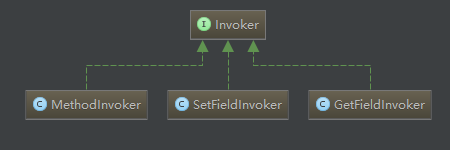全民欢庆的五一劳动节,可谓是赏花赏月赏秋香的好季节,炎炎夏日,柳絮飞扬,短裙飞舞,低胸抢镜,是旅游撩妹裸奔等精彩活动的不二选择,不过,这显然与我无关。
终于要开启Mybatis的初始化过程分析了,是不是等的花儿都要开放了呢?
一般的框架分析思路都是从启动、初始化说起,然而,由于没有心理准备,初始化过程中会瞬间涌入大量的概念、类等等,类之间又存在爆炸性延伸,反而吓退了读者,有种吃不下这块肥肉的感觉。所以,我选择优先介绍一些易于理解的框架概念,然后再阅读和分析框架的启动和初始化流程,有了事先的精心准备,肥肉也就不再肥了。
我一直在反思,我的博文是否写的过长了,读者是否读的很累,是否没有描述清楚内容,是否没有抓住重点。因此,我大胆创新了博文的写作模式,叫精炼博文。
Mybatis的初始化过程,就是组装Configuration的过程,在这个过程中,用到了一些工具,我列举了六个基本工具,如图所示。

(Made In Edrawmax)
图中展示了XMLConfigBuilder为了组装出Configuration对象所作出的努力,配备了至少六个基本工具。本文的重点,就是分析这六个工具的作用。
好怕怕啊,一下子分析六个那么多。别怕,每个工具不超过三行代码,你就会彻底明白(相信你自己)。
1. ObjectFactory
ObjectFactory objectFactory = new DefaultObjectFactory();
List<String> list = objectFactory.create(ArrayList.class);
list.add("apple");
System.out.println(list);
out put:
[apple]ObjectFactory:反射创建对象工厂类。
2. Reflector、Invoker、ReflectorFactory
ObjectFactory objectFactory = new DefaultObjectFactory();
Student student = objectFactory.create(Student.class);
Reflector reflector = new Reflector(Student.class);
Invoker invoker = reflector.getSetInvoker("studId");
invoker.invoke(student, new Object[] { 20 });
invoker = reflector.getGetInvoker("studId");
System.out.println("studId=" + invoker.invoke(student, null));output:
studId=20代码逻辑:使用默认构造方法,反射创建一个Student对象,反射获得studId属性并赋值为20,System.out输出studId的属性值。

(Made In Intellij Idea IDE)
Invoker:反射类Class的Method、Field封装。
GetFieldInvoker等于从Field取值:field.get(obj)。
SetFieldInvoker等于给Field赋值:field.set(obj, args[0])。
MethodInvoker等于Method方法调用:method.invoke(obj, args)。
Reflector:保存一个类Class的反射Invoker信息集合。
DefaultReflectorFactory。
private final ConcurrentMap<Class<?>, Reflector> reflectorMap = new ConcurrentHashMap<Class<?>, Reflector>();缓存了多个类Class的反射器Reflector。(避免一个类,多次重复反射)
3. XPath、EntityResolver
<?xml version="1.0" encoding="UTF-8"?>
<!DOCTYPE configuration PUBLIC "-//mybatis.org//DTD Config 3.0//EN" "http://mybatis.org/dtd/mybatis-3-config.dtd">
<configuration>
<settings>
<setting name="defaultExecutorType" value="REUSE" />
<setting name="defaultStatementTimeout" value="25000" />
</settings>
<mappers>
<mapper resource="com/mybatis3/mappers/StudentMapper.xml" />
<mapper resource="com/mybatis3/mappers/TeacherMapper.xml" />
</mappers>
</configuration>XPath,是针对Xml的“正则表达式”。
我们使用XPath技术,来编写一个小例子。
DocumentBuilderFactory builderFactory = DocumentBuilderFactory.newInstance();
builderFactory.setValidating(false);
DocumentBuilder builder = builderFactory.newDocumentBuilder();
// builder.setEntityResolver(new XMLMapperEntityResolver());
InputSource inputSource = new InputSource(Resources.getResourceAsStream("mybatis-config.xml"));
Document document = builder.parse(inputSource);
XPathFactory xPathFactory = XPathFactory.newInstance();
XPath xpath = xPathFactory.newXPath();
String value = (String) xpath.evaluate("/configuration/settings/setting[@name='defaultStatementTimeout']/@value", document, XPathConstants.STRING);
System.out.println("defaultStatementTimeout=\"" + value + "\"");
Node node = (Node) xpath.evaluate("/configuration/mappers/mapper[1]", document, XPathConstants.NODE);
NamedNodeMap attributeNodes = node.getAttributes();
for (int i = 0; i < attributeNodes.getLength(); i++) {
Node n = attributeNodes.item(i);
System.out.println(n.getNodeName() + "=\"" + n.getNodeValue() + "\"");
}output:
defaultStatementTimeout="25000"
resource="com/mybatis3/mappers/StudentMapper.xml"/configuration/settings/setting[@name='defaultStatementTimeout']/@value
含义为:取configuration下面的settings下面的属性name值等于defaultStatementTimeout的setting节点的value属性值。
/configuration/mappers/mapper[1]
含义为:取configuration下面的mappers下面的第1个mapper节点。
XPathConstants.STRING:说明获取的目标对象是一个String值。
XPathConstants.NODE:说明获取的目标对象是一个Node节点。
如果使用上面的代码运行XPath,程序将像蜗牛一样缓慢,问题原因是Xml内部的:
http://mybatis.org/dtd/mybatis-3-config.dtdJDK会使用网络,去上面这个地址下载dtd文件,并解析,所以慢的像蜗牛(和网络环境有关)。
builder.setEntityResolver(new XMLMapperEntityResolver());加入上面这句话,程序瞬间快如闪电。XMLMapperEntityResolver是Mybatis针对EntityResolver的实现类,它从本地环境去寻找dtd文件,而不是去网络上下载,所以,速度飞快。
Mybatis就是通过上面六个工具,去读取配置文件的。工具虽多,但架不住我三两句话把它描述清楚,避免长篇大论。
4. Mybatis中的XNode和XPathParser
上面有关XPath的例子,示例了解析一个String和一个Node。假设我想要解析Float类型和List<Node>集合,那么需要简单封装一下。
public Float evalFloat(Object root, String expression) {
return Float.valueOf((String)(xpath.evaluate(expression, root, XPathConstants.STRING)));
}
public List<Node> evalNodes(Object root, String expression) {
NodeList nodeList = (NodeList) xpath.evaluate(expression, document, XPathConstants.NODESET);
List<Node> list = new ArrayList<Node>();
for (int i = 0; i < nodeList.getLength(); i++) {
Node n = nodeList.item(i);
list.add(n);
}
return list;
}除了Float和List<Node>,可能还有Integer、Double、Long等类型,于是,Mybatis把这些方法封装到一个类中,取名叫XPathParser。
在面对一个Node时,假设我想要把Node的属性集合都以键、值对的形式,放到Properties对象里,同时把Node的body体也通过XPathParser解析出来,并保存起来(一般是Sql语句),方便程序使用,代码可能会是这样的。
private Node node;
private String body;
private Properties attributes;
private XPathParser xpathParser;Mybatis又把上面几个必要属性封装到一个类中,取名叫XNode。
这就是这俩兄弟的来历。概念多了易乱,可以忽视XNode和XPathParser的存在,心中只有Node和XPath。
精炼博文模式,读读更健康,她好我也好。
版权提示:文章出自开源中国社区,若对文章感兴趣,可关注我的开源中国社区博客(http://my.oschina.net/zudajun)。(经过网络爬虫或转载的文章,经常丢失流程图、时序图,格式错乱等,还是看原版的比较好)
来源:oschina
链接:https://my.oschina.net/u/2727738/blog/668596